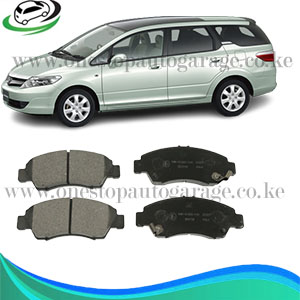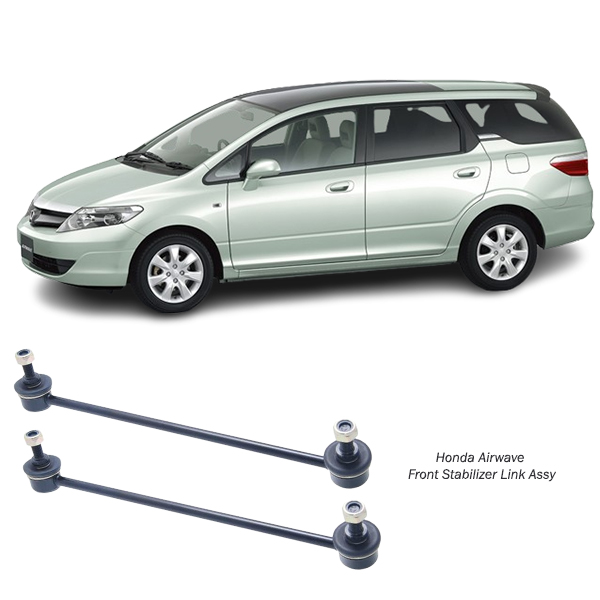-10%
Get Honda Airwave Front Stabilizer Link Assy SLH060 in kenya
The front stabilizer link assembly is an essential component of a vehicle’s suspension system, contributing to handling stability, cornering performance, and overall driving comfort. Often overlooked, this component plays a vital role in maintaining the safety and balance of the car, especially during sharp turns or uneven road conditions. This guide delves into its structure, functions, benefits, maintenance tips, and troubleshooting for an in-depth understanding.
What is a Front Stabilizer Link Assembly?
A front stabilizer link assembly (also called a sway bar link) is a component that connects the front stabilizer bar (or sway bar) to the vehicle’s suspension system. This linkage helps the stabilizer bar perform its function of reducing body roll during cornering or driving over uneven surfaces.
The stabilizer link assembly acts as a mediator, transmitting forces from the stabilizer bar to the suspension control arms. This mechanism ensures the wheels remain in better contact with the ground, improving stability and handling.
Functions of the Front Stabilizer Link Assembly
The stabilizer link assembly has several critical functions, including:
- Reducing Body Roll
- Prevents excessive tilting of the vehicle’s body during cornering, ensuring stability and safety.
- Improving Handling
- Enhances the vehicle’s steering response by maintaining proper wheel alignment during dynamic driving conditions.
- Maintaining Suspension Balance
- Distributes forces evenly across the suspension system, improving ride comfort.
- Absorbing Road Shocks
- Dampens the impact of bumps and potholes, minimizing vibrations transferred to the cabin.
- Enhancing Tire Grip
- Ensures the tires remain in optimal contact with the road surface for better traction and control.
Construction of a Front Stabilizer Link Assembly
The stabilizer link assembly is designed for durability and efficiency. It typically consists of:
- Link Rod
- A sturdy metal rod that connects the stabilizer bar to the suspension components.
- Ball Joints
- Flexible joints at both ends of the link rod that allow for multi-directional movement.
- Rubber Bushings
- Shock-absorbing bushings that reduce vibrations and prevent metal-on-metal contact.
- Mounting Hardware
- Bolts and washers secure the stabilizer link to the stabilizer bar and suspension system.
- Protective Coating
- A layer of corrosion-resistant material shields the assembly from rust and environmental damage.
Types of Front Stabilizer Link Assemblies
Depending on the vehicle and driving conditions, stabilizer link assemblies come in various designs:
- Standard Links
- Common in most passenger vehicles; simple and effective for everyday driving.
- Adjustable Links
- Feature an adjustable length for custom suspension setups, often used in performance or off-road vehicles.
- Heavy-Duty Links
- Built with reinforced materials for added strength, suitable for trucks and SUVs.
- Ball-Jointed Links
- Use ball-and-socket joints for increased flexibility and reduced wear.
Benefits of a Front Stabilizer Link Assembly
- Improved Stability
- Keeps the vehicle balanced during sharp turns and quick maneuvers.
- Enhanced Safety
- Reduces the risk of rollovers by controlling body lean.
- Better Handling
- Improves steering precision and responsiveness.
- Increased Comfort
- Absorbs shocks and vibrations, leading to a smoother ride.
- Extended Tire Life
- Promotes even tire wear by maintaining proper alignment and reducing stress on the tires.
How the Front Stabilizer Link Assembly Works
- Force Transmission
- When the vehicle corners, the stabilizer bar twists to counteract body roll. The stabilizer link transfers this force to the suspension components.
- Balance Maintenance
- The link ensures that forces are distributed evenly between the left and right wheels, maintaining balance.
- Flexibility
- The ball joints and bushings allow the stabilizer link to flex and move with the suspension, ensuring smooth operation.
Signs of a Failing Front Stabilizer Link Assembly
Like any mechanical part, the stabilizer link assembly can wear out over time. Common symptoms of failure include:
- Clunking or Rattling Noises
- Noises from the suspension area, especially when driving over bumps or during cornering.
- Poor Handling
- Reduced steering responsiveness and difficulty maintaining control during turns.
- Uneven Tire Wear
- Accelerated wear on one side of the tire due to poor alignment or balance.
- Excessive Body Roll
- Noticeable leaning of the vehicle during turns or sharp maneuvers.
- Visible Damage
- Cracked bushings, bent rods, or damaged ball joints upon inspection.
Maintenance Tips for Front Stabilizer Link Assemblies
- Regular Inspections
- Check the stabilizer links during routine vehicle maintenance for signs of wear or damage.
- Lubrication
- Keep ball joints and bushings lubricated to reduce friction and extend their lifespan.
- Avoid Overloading
- Excessive vehicle weight can stress the suspension system, including the stabilizer links.
- Replace in Pairs
- When replacing one stabilizer link, replace the other on the same axle to maintain balance.
- Use Quality Parts
- Opt for OEM or high-quality aftermarket stabilizer links for durability and reliability.
Replacing a Front Stabilizer Link Assembly
Replacing a front stabilizer link assembly is a straightforward process for most vehicles. Here are the general steps:
- Prepare the Vehicle
- Park the car on a flat surface and secure it with jack stands.
- Remove the Old Link
- Loosen the bolts connecting the stabilizer link to the stabilizer bar and suspension. Remove the damaged link.
- Install the New Link
- Position the new stabilizer link and secure it with the provided bolts and washers.
- Torque to Specifications
- Tighten the bolts to the manufacturer’s recommended torque settings.
- Test the Vehicle
- Take the vehicle for a test drive to ensure proper handling and eliminate any noises.
Common Issues with Front Stabilizer Link Assemblies
- Bushing Deterioration
- Over time, the rubber bushings can crack or wear out, leading to increased vibrations and noise.
- Ball Joint Wear
- Excessive movement or noise may indicate worn ball joints.
- Corrosion
- Exposure to moisture and road salt can cause rust, weakening the stabilizer link.
- Impact Damage
- Potholes or collisions can bend or break the stabilizer link rod.
- Improper Installation
- Incorrect torque settings or misalignment can lead to premature failure.
Conclusion
The front stabilizer link assembly is a small yet vital part of the suspension system, ensuring stability, safety, and comfort. Proper care, timely replacement, and high-quality components are essential to maintain its performance. By understanding its role, construction, and maintenance needs, drivers can ensure their vehicle remains safe and responsive on the road. Whether for daily commuting or spirited driving, the stabilizer link assembly is indispensable for a smooth and controlled driving experience.
Follow us on Facebook for more parts.



